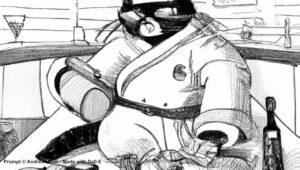Open AI allows the ‘paying customer’ to freely use the images produced by the Dall-E text-to-image, as long as they indicate that it was made via the platform. This means, reading the clause ‘backwards’, nothing prohibits the company from restricting authors’ rights to the prompt – the description users provide to the software to obtain an image by Andrea Monti – Initially published in Italian by Strategikon – an Italian Tech Blog.
Canva has recently activated text-to-image functionality with the novelty that images generated through prompts from paying users are acquired under a free licence for use in marketing activities.
As in the ‘data for service’ business model or in that practised by social networks on user-generated content, some might say that the fee is ‘included’ in the price and that services would cost more if there were not also this retrocession of rights on prompts. Perhaps, but at least in the case of Canva, this is not made clear. Even if it were, indeed, it would constitute yet another act of appropriation of human individuality that, from the expropriation of data, now extends to that of ideas.
The prompt that spawned it, the truly creative act, is the copyrighted part of text-to-image generated content. Dall-E, Midjourney, Stable Diffusion and, now, Canva’s text-to-image are, in fact, just tools. Sophisticated as you like, but just tools. What makes the difference is, instead, the human ability to write a creative description of the image (where by ‘creative’ we don’t mean the myriad of idiocies like ‘black-and-white ink sketch in the style of Frank Miller of a cute cat-chef in cyberpunk style, cooking sushi in a starry restaurant at the end of the universe for a bunch of Vogons’).

So, invoking some rights of platform owners over the user’s thoughts would be like saying that the owner of the chisels used by Michelangelo to sculpt the Pieta can claim some ownership over the work because, without them, the artist could not have created the masterpiece. This is impossible because the tool has no subjectivity, but it matters little. While the ‘experts’ wonder about the ‘AI right’, the market pragmatically solves the issue with the ‘Swiss army knife’ of copyright: the user licence. A contract, indeed, is a traditional, outdated, dusty but a still tremendously effective legal instrument.
Canva, too, like Open AI, uses contract to limit freedom in the use of the software. They maintain the power to actively block prompts with explicit (but not illegal) content and those that represent a stereotype or are affected by bias, even if nobody knows where this ‘right’ comes from.
This choice reinforces the observation of how ‘ethical’ control over people’s thinking is reaching new and worrying levels of pervasiveness. A small number of ‘ethicists’, more or less unknown to the general public and probably flanked by legions of lawyers and jurists, have the power to decide whether or not one can use –no, on Dall-E, it is not possible– the photographic jargon ‘shot’ to refer to a shot, because the original meaning of the word is ‘shot’. As long as we are talking about photographs, no harm is done, but it is clear that this is not what we are talking about.
The theme of appropriation of ideas goes back a long way, back to the days of the alarms over the control of vocabularies and spell-checkers. It was 2003, less than twenty years ago, but it seems like centuries since I wrote that
“Generations of functional illiterates enslaved to the uncritical use of a single platform are being created. Users who already use systems without any awareness of what they are doing. And so, when the spell-checker says that the word ‘democracy’ is not in the vocabulary, without asking questions they will simply stop using it. And to think about it.”
Today, not only has this nightmare that seemed dystopian at the time started to materialise, but it does so by taking on more frightening forms.
Writing a prompt is tantamount to ‘programming’ a text-to-image platform and a fortiori, a machine translation system. But to do this efficiently, one must use the syntactic and grammatical forms that work best and not necessarily the most creative ones. The consequence is that the language bends to the needs or limitations of the software and becomes progressively impoverished. To what extent and when this will happen is unknown. However, Big Tech’s strategic choices already led to losing control over words in favour of a small group of subjects.
We will talk about it again in twenty years if we can still express ourselves in a way that humans can understand or if we have the right to do so without paying a licence fee.
